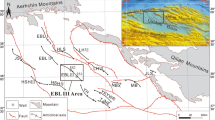Abstract
The Precipitation of carbonate cements in the Pobitite Kamani area (Lower Eocene) began during early diagenesis of sediments. There is evidence, however, that calcite is still forming today.
The negative δ13C values to −29.2‰ suggest that the carbonate formed during degradation of 12C-enriched organic matter (perhaps partly from oxidation of methane). The δ18O values of −0.9 to −1.6‰ reflect the marine origin of the early diagenetic carbonate cements. Most of the carbonates, however, formed during late diagenesis (at approximately 1300 m burial depth) and/or recently (after uplift) from percolating groundwaters. These carbonates have an isotopic composition characteristic of carbonates which precipitated from meteoric waters under normal sedimentary temperatures in isotopic equilibrium with 12C-enriched soil carbon dioxide.
Similar content being viewed by others
References
Aladjova-Khrischeva K (1984) Stratigraphie des depots Eocene aux environs du village Beloslav, departement de Varna. Rev Bulg Geol Soc 45: 33–44
Craig H (1953) The geochemistry of the stable carbon isotopes. Geochim Cosmochim Acta 3: 53–92
Emrich K, Ehhalt DH, Vogel JC (1970) Carbon isotope fractionation during the precipitation of calcium carbonate. Earth Planet Sci Lett 8: 363–371
Irwin H (1980) Early diagenetic carbonate precipitation and pore fluid migration in the Kimmeridge clay of Dorset, England. Sedimentology 27: 577–591
Keeling JD (1958) The concentration and isotopic abundance of carbon dioxide in rural areas. Geochim Cosmochim Acta 13: 322–334
McCrea JM (1950) The isotope chemistry of carbonates and a paleotemperature scale. J Chem Phys 18: 849–857
Willer G, Gastner M (1971) The “Karbonatbombe”: a simple device for the determination of the carbonate content in sediments, soils and other materials. N Jahrb Miner Mh 10: 466–469
Nacev I, Mandev P, Zhelev S (1986) “Pobitite kamani” — algal bioherms. Rev Bulg Geol Soc 47: 1–13
Schoell M (1980) The hydrogen and carbon isotopic composition of methane from natural gases of various origins. Geochim Cosmochim Acta 44: 649–661
Silverman SR, Epstein S (1958) Carbon isotopic composition of petroleums and other sedimentary organic materials. Am Assoc Petrol Geol Bull 42: 998–1012
Author information
Authors and Affiliations
Rights and permissions
About this article
Cite this article
Botz, R.W., Georgiev, V., Stoffers, P. et al. Stable isotope study of carbonate-cemented rocks from the Pobitite Kamani area, north-eastern Bulgaria. Geol Rundsch 82, 663–666 (1993). https://doi.org/10.1007/BF00191493
Received:
Accepted:
Issue Date:
DOI: https://doi.org/10.1007/BF00191493




